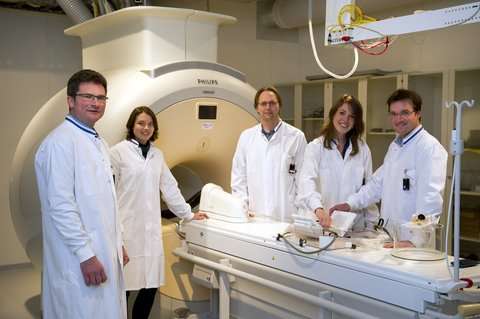New research highlights potential of MR-HIFU technology for new cancer therapies

Researchers from Eindhoven University of Technology, Philips Research and University Hospital of Cologne explored how a combination of ultrasound (HIFU), MRI imaging and drug-loaded temperature sensitive nanoparticles could be used to improve cancer treatment efficacy. Nicole Hijnen, Mariska de Smet, Esther Kneepkens, professor Holger Grüll and colleagues published the results of this preclinical study in the Proceedings of the National Academy of Science (PNAS) – one of the world's most prestigious scientific journals.
TU/e and Philips Research have been carrying out research for a number of years into the image-guided administration of medication using 'delivery vehicles' (MR-HIFU): temperature-sensitive liposomes that transport the medication through the body to the tumor, which can be imaged after drug release. The location of the tumor is identified using MRI, after which the tumor is warmed by means of ultrasound (hypertherma). When the liposomes reach the tumor, the increased temperature causes them to open so that the medication and contrast medium are released.
Elevation of tissue temperature
The new scientific research detailed in the PNAS paper focuses on the combined use of MR-HIFU induced hyperthermia (elevating the tissue temperature to between 40oC and 43oC) to locally deliver chemotherapeutics, and thermal ablation (the elevation of tissue temperature to above 55oC) to locally treat tumor tissue while minimizing collateral damage to healthy tissue.
Specifically, the researchers investigated the efficacy of these therapies to treat rhabdomyosarcoma (skeletal muscle tumor) in a pre-clinical model. Special attention was paid to the distribution of released medicine (doxorubicin) in the margins of the tumor and surrounding tissue before and after applying both thermal therapies to the tumor core. Simultaneous MR imaging provides real-time anatomical imaging of the treatment area, while the MR signal itself can be used to measure the instantaneous temperature at any point in the tumor, providing the real-time feedback required for accurate temperature control and profiling.
Protocol
The aim was to establish a protocol that would not only destroy the bulk of the tumor by heat but also treat tumor cells in the tumor margin while sparing surrounding tissue. The most effective protocol in terms of survival was found to be injection of the Doxorubicin-loaded liposomes, and then two 15-minute sessions of hyperthermia followed by ablation of the tumor core, which increased survival time threefold compared to unheated administration of Doxorubicin.
"The PNAS paper shows the unique potential of MR-HIFU technology that enables hyperthermia to locally release drugs and thermal ablation in a single procedure," said Edwin Heijman PhD, Senior Research Scientist, Department Oncology Solutions at Philips Research, and one of the authors.
"These results form the basis for future translation to the clinic", adds Holger Grüll, part-time professor at Eindhoven University of Technology and working at University Hospital of Cologne. "In the coming years we will develop this technology further, along with Philips Research and the hospital in Cologne, for a possible application to the patient."
More information: Nicole Hijnen et al. Thermal combination therapies for local drug delivery by magnetic resonance-guided high-intensity focused ultrasound, Proceedings of the National Academy of Sciences (2017). DOI: 10.1073/pnas.1700790114
















